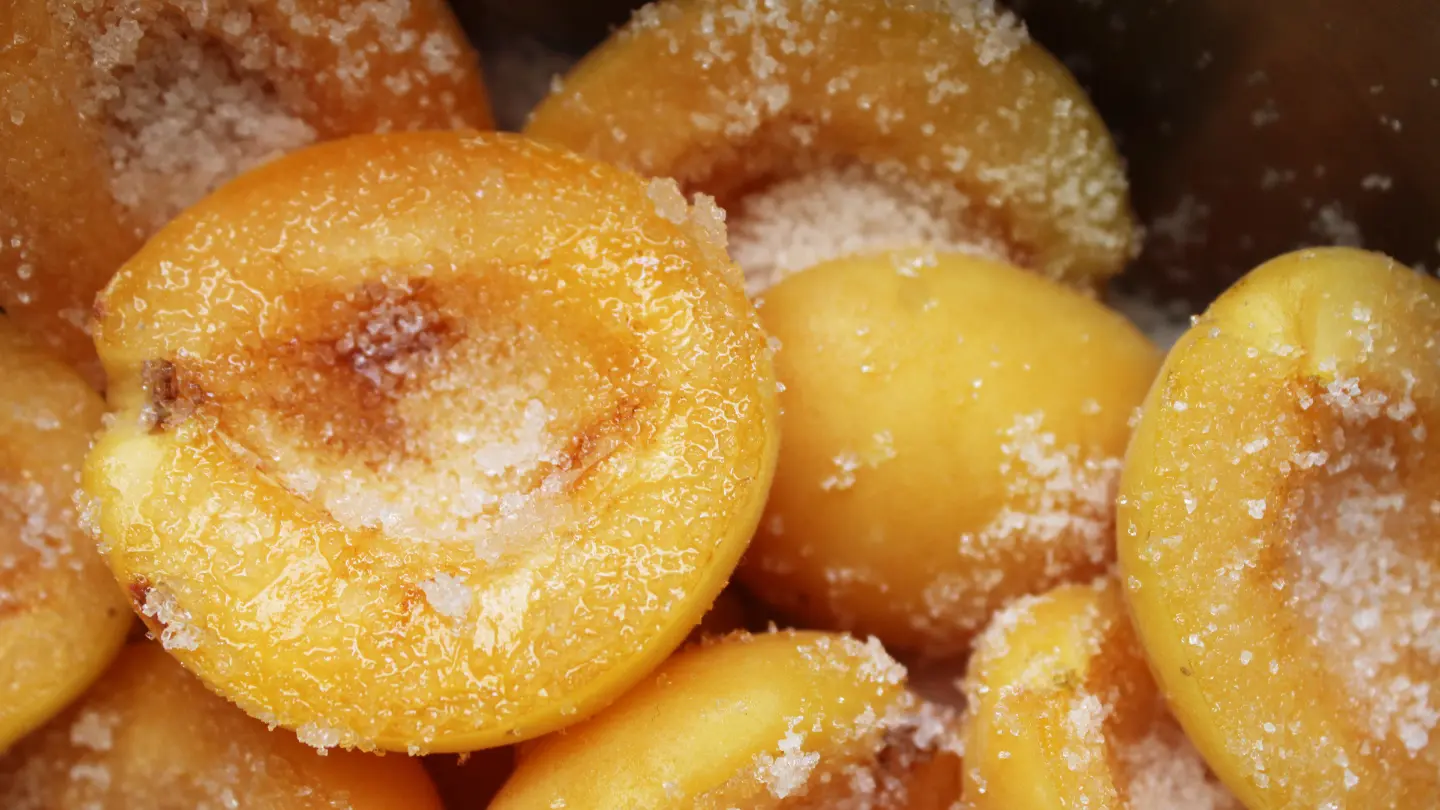Apricots are juicy fruits rich in fiber and vitamins A and C. This is why at first glance they seem like a healthy choice.
However, every curious diabetic wonders: Do apricots have a low or high glycemic index. Moreover, how do they affect blood sugar with their natural sugar content?
As a Master in Nutrition, I give you evidence, conclusions, and more concrete advice based on scientific sources.
Note: the text is informative and does not replace the advice of a doctor or a personal nutritionist. Before making a major change in diet, be sure to consult a specialist and monitor your glucose levels.
🍑 Brief Conclusions: What You Need To Know
- Apricots are not prohibited for people with diabetes. The key is in the preparation, quantity and context of the meal. Choose whole, unsweetened fruits, watch your portion, and combine them with protein, fat, and extra fiber to reduce the glycemic response.
- Apricots have a low glycemic index (~34 for fresh fruit) and moderate carbohydrate content. They don't usually cause sudden spikes in blood sugar.
- Dried (dried) apricots contain more concentrated sugars compared to fresh (but more fiber). And they are relatively low glycemic index (daily GI of dried apricots around 42), so they can be consumed in small quantities.
- Canned apricots (in sweet syrup) are not good for people with diabetes. They contain extra sugars and a significantly higher GI (about 60). The best fruit to use is fresh or frozen without sugar.
- Include protein and healthy fats (yogurt, nuts, etc.) with apricots. Additional fiber with a low sugar and fat content slows down the absorption of glucose from the fruit and reduces the glycemic “jump”.
- The recommended serving of fresh apricots for diabetics is about 3—4 medium-sized fruits (≈15 g of carbohydrates), which is considered one common serving of carbohydrates. If you eat about 150—200 g of fresh fruit (approximately 3—4 medium-sized apricots), you will enter one standard serving of carbohydrates recommended by the guidelines.
- In type 1 diabetes, it is important to apply a portion of insulin in advance (pre-bolus) because the sugar from the fruit is absorbed quickly. Monitoring sugar levels and using a CGM device can help adjust the insulin dose when consuming apricots.
- Apricots are rich vitamins A, vitamin C, potassium and antioxidants. These nutrients (especially β-carotene from vitamin A) help maintain eye and heart health and neutralize free radicals.
- While fruit trees are generally high in calories due to sugar, apricots have a relatively low calorie density (≈48 kcal per 100 g) thanks to its high water content.
Apricots and blood sugar: GI and fiber

The main reason why diabetics are wary of apricot intake is the content of natural sugars (fructose) and their glycemic index (GI).
Fresh apricots have a GI of around 34. This places them among some fruits with a low glycemic index.
In other words, fresh fruits slowly release glucose into the bloodstream and rarely cause a sharp rise in blood sugar (with moderate consumption). In comparison, white bread has a GI of over 70. As you can see, fresh apricots have a lower glycemic index and are allowed if consumed wisely.
Dried apricots, in comparison, are more concentrated.
Study from 2018, which also investigated dates and diabetes, showed that dried apricots have a GI of about 42. This is still significantly lower than white bread. Still, people with diabetes should eat them in moderation. In the same study, the introduction of half of the carbohydrates from white bread in the form of dried apricots lowered the overall glycemic response by more than 50%.
The abundance of fiber in apricots helps to slow down the absorption of glucose
You can expect a single fruit to have ~0.7g of fiber. This may sound small, but the fiber in the fruit is distributed in multiple fruits per serving.
As is pointed out in Harvard studio, people who consume enough fiber have a significantly lower incidence of heart disease and type 2 diabetes. In other words, fiber from apricots helps keep glucose more stable, can be”natural remedy for fat in the blood“, and supports heart health.
Furthermore, apricots, like peaches, contain antioxidants (vitamin C, carotenoids) that protect cells from oxidative stress.
Vitamin C from fruits works by neutralizing free radicals, and vitamin A (β-carotene) from apricots especially preserves eye health and can reduce inflammation.
Preparation and combinations: Fresh, dry and canned

The way you prepare and eat these fruits drastically changes their effect on blood sugar. Let's take a quick look at which form of consumption is best for you.
Fresh apricots and diabetes: The best choice for the daily diet
Fresh apricots are an ideal choice for people with diabetes. They are nutritious, contain about 48 calories and only 9 g of carbohydrates per 100 g, and have a high level of water (about 85%).
They are an immediate source of vitamins and fiber that don't cause huge jumps in blood sugar levels.
Dried apricots: How much to consume them wisely
Dried apricots (without added sugar) retain most of the vitamins and minerals, but have a higher calorie and carbohydrate density. That is why they should be consumed wisely because they do not help maintain lower insulin levels.
Although slightly less sugary, they still have a low to moderate glycemic index and can fit into a diabetic's diet plan if combined with fat and protein.
For example, you can add them to yogurt, salads or oatmeal, but they should not be the main source of carbohydrates.
Canned Apricots: Avoid Added Sugar
Canned fruits in syrup should be avoided because they contain large amounts of added sugar and have a glycemic index of around 60. Such products quickly raise blood sugar levels and have low nutritional value.
If you already like canned fruit, choose variants without added sugar. Fruit juices can be sweet enough on their own. Sugar-free frozen apricots are an even better alternative.
The combination of apricots with fiber and healthy fats for stable blood sugar
Adjusting meals is key for people who have diabetes. It is best to combine apricots with fiber, protein and healthy fats, for example in a salad with olive oil, in yogurt with nuts or with Greek yogurt (otherwise one of my favorite foods).
Such combinations slow down the absorption of glucose, thereby preventing a sharp jump in blood sugar and prolonging the feeling of satiety.
How many apricots are safe?

There is no “universal” dose for all types of fruit, but manuals for diabetics often calculate that one serving of fruit contains 15 g of carbohydrates. J
one medium-sized fresh apricot (35—40 g) has about 4 g of carbohydrates, so three to four apricots are approximately 15 g of carbohydrates. So, a portion of 100—150 g (3—5 fruits) is considered permissible for most diabetics.
In the context of meals, protein and vegetables are then usually planned in addition to apricots to further slow down the absorption of sugar.
People with type 1 diabetes need extra care.
Although apricots are low GI, their glycemic effect can be felt quickly. It is advised prebolussinginsulin (administration before meals) and monitoring of sugar after meals (e.g. using a CGM device) so that the insulin arrives to cover the sugar from the apricots in time.
For type 2 diabetics, it is important to take into account the total calorie and carbohydrate intake of the day. In both cases, the message is the same. Consult a doctor or nutritionist and consume apricots in moderation and within diet planfor diabetes and be sure to consult a doctor or personal nutritionist if you want to make major changes.
Is apricot a good idea for people with diabetes?
Despite the content of natural sugars, apricots do not have to be completely eliminated from the diabetic diet. If diabetics want to eat them, the key is in the amount and method of consumption.
Whole apricots contain fiber and antioxidants that slow the growth of blood sugar, making them a much better choice than sugary snacks or fruit drinks with added sugar.
For comparison, in Healthline Guide to Fruits for Diabetics, apricots are listed among examples of low-GI fruits, along with berries and peacheshealthline.com. So, like berries, apricots can be “good” for diabetics if eaten fresh and with caution.
From the point of view of prevention, more recent research even suggests the beneficial effects of moderate intake of dried apricots and other dried fruits. For example, Mendelian analysis of genetic datashowed that an increase in the daily portion of dried apricots (about 1—2 pieces) significantly reduces the risk of developing type 2 diabetes.
Although caution because dried apricots have more calories and sugar per 100 g. These findings show that including them in moderation in the diet can even be beneficial for metabolism in the long term.
Apricots are a good source of vitamins and minerals
They contain vitamin A, C, potassium, antioxidants and fiber for people with diabetes. Given this, what dictates their effect is the context. Fresh apricots in small portions, in addition to other foods, contribute to the distribution of vitamins and fiber in the meal and help maintain a stable blood sugar.
Unlike highly processed snacks, they bring nutritional benefits (e.g. vitamin C helps reduce free radicals, and potassium contributes to the regulation of heart rhythm).
Apricots are not “black and white” when it comes to diabetes
They belong to the group of fruits with a low glycemic index and a lot of vitamins, but care should be taken with the portion and preparation.
For healthy choices, choose fresh or slightly dried fruits without sugar, avoid preserves in syrup, and always combine apricots with foods that slow digestion (fiber, healthy fats and proteins).
With this approach, apricots can be a sufficient and tasty addition to the diabetic menu. For more specific tips on incorporating fruit into your diet, be sure to consult your doctor or personal nutritionist.
For additional tips on how to balance diet and blood sugar, read other articles on my blog:
- Sweet Potato and Diabetes: How Does Sugar Affect?
- Dates and diabetes
- Corn flour and diabetes
- Nutrition and training: how to find balance




.svg)













